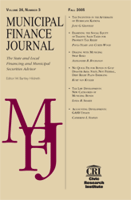Do Competitive-Only Laws Have an Impact on the Borrowing Cost of Municipal Bonds?
Author: Jun Peng.; Peter F. Brucato, Jr..
Source: Volume 22, Number 03, Fall 2001 , pp.61-76(16)

< previous article |next article > |return to table of contents
Abstract:
There are two main methods of selling debt issues in the municipal bond market: competitive bidding and negotiated sale. There has long been a debate over which method of sale results in lower interest cost. Some argue that competitive bidding leads to lower borrowing cost because of the competition. The monopsony power enjoyed by underwriters in negotiated sales may allow them to reap a larger profit than they should at the expense of government issuers. In addition to the economic efficiency argument, there is another argument about political accountability, with regard to the pay-to-play issue. Pay-to-play refers to the fact that some municipal securities dealers make political contributions to government officials in hopes of getting favorable business deals in future negotiated sales. These two arguments are tied to each other. Government officials may put their own political interests ahead of taxpayers’ interests by selecting a particular underwriter in a negotiated sale that may not produce the lowest borrowing cost (Simonsen and Hill, 1999). Many governments have therefore set rules to the effect that debt issues have to be sold by competitive bidding, thus prohibiting negotiated sale altogether. On the other hand, there is another body of literature arguing that negotiated sale may have a cost advantage over competitive sale in certaincircumstances, especially when the market is unstable and when the issues being sold are of low-credit quality. Negotiated sale is a better choice because it allows for flexible timing and for more time for the investors to get familiar with the debt issues. If debt issues are forced to be sold through competitive bidding in these circumstances because of some law, the interest cost may actually go up rather than down. In light of these different views about the cost differential between these two methods of sale, this article attempts to find out what impact the competitive-only rule may have on government debt issuers’ borrowing cost.Keywords:
Affiliations:
1: University of Arizona School of Public Administration and Policy; 2: Cricket Asset Management.